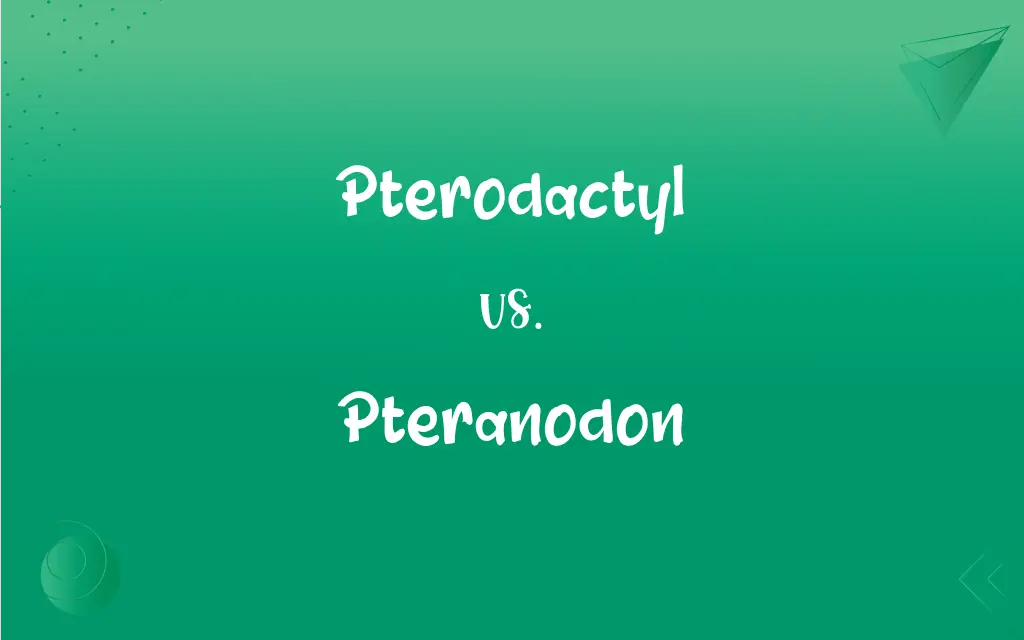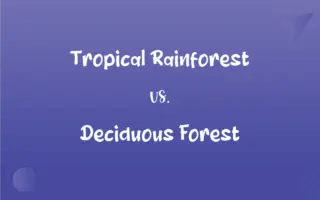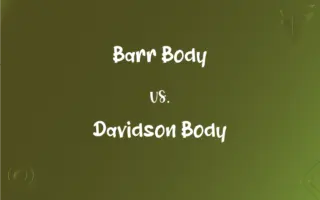Pterodactyl vs. Pteranodon: What's the Difference?
Edited by Aimie Carlson || By Janet White || Published on February 10, 2024
Pterodactyls, part of Pterosauria, had long tails and small heads, whereas Pteranodons, a specific genus, had large heads and tailless bodies.

Key Differences
Pterodactyls were flying reptiles known for their long tails and small heads, and were part of a larger group known as Pterosauria. Pteranodons, on the other hand, were notable for their large heads and pronounced crests, belonging to a specific genus within Pterosauria. Both lived during the Mesozoic Era but had distinct anatomical features.
Pterodactyls had teeth in their beaks, a characteristic of their subgroup Pterodactyloidea,while pteranodons were toothless. This difference in dental anatomy suggests variations in diet and feeding strategies between the two. Each species within these groups adapted to their specific ecological niches.
The wingspans of pterodactyls varied greatly, with some species having relatively modest wingspans. In contrast, pteranodons were among the largest pterosaur species, with some individuals having wingspans exceeding 20 feet. This size difference had implications for their flight abilities and lifestyle.
Pterodactyls often had longer tails, which were used for balance and maneuverability in flight. Pteranodons, however, had very short tails, a feature that distinguished them within the Pterosauria class. This anatomical difference suggests variations in their flight patterns and behaviors.
Both pterodactyls and pteranodons lived near water, but pteranodons are more frequently associated with coastal environments. They likely fed on fish, as evidenced by their fossils found in regions that were ancient seas.
ADVERTISEMENT
Comparison Chart
Tail Length
Long tails
Virtually tailless
Head Size
Smaller heads
Larger heads with pronounced crests
Teeth
Teeth present in beaks
Toothless
Wingspan
Variable, often smaller
Among the largest in pterosaurs, up to 20 feet or more
Preferred Environment
Varied, often near water
Primarily coastal environments
ADVERTISEMENT
Pterodactyl and Pteranodon Definitions
Pterodactyl
A member of the Pterosauria class, distinguished by its long-tailed body structure.
Scientists discovered pterodactyl fossils in desert regions.
Pteranodon
A large, tailless flying reptile from the Cretaceous period.
The pteranodon's silhouette was distinct against the sunset.
Pterodactyl
A reptile with a wingspan ranging from small to moderate.
The pterodactyl had a wingspan that overshadowed the surrounding plants.
Pteranodon
A genus of Pterosauria, known for its toothless beak and large crest.
The pteranodon is easily recognized by its striking head crest.
Pterodactyl
A prehistoric flying reptile with a long tail.
The pterodactyl soared above the ancient forests.
Pteranodon
A coastal dweller, likely a fish eater, with a unique head structure.
Fossils suggest the pteranodon dived into the water to catch its prey.
Pterodactyl
An extinct flying creature, part of the Pterosaur group.
The museum's exhibit on pterodactyls attracted many curious visitors.
Pteranodon
One of the largest known flying reptiles, with an extensive wingspan.
The pteranodon could glide for long distances over ancient seas.
Pterodactyl
A Jurassic era reptile known for its aerial abilities and distinct tail.
The pterodactyl is often depicted in movies about prehistoric times.
Pteranodon
A prominent figure in paleontological studies for its distinct anatomy.
Paleontologists often study pteranodon fossils to understand pterosaur flight.
Pterodactyl
Any of various pterosaurs of the group Pterodactyloidea of the Jurassic and Cretaceous Periods, having a short tail or no tail, and including the pteranodons.
Pteranodon
Any of several large pterosaurs of the genus Pteranodon of the Cretaceous Period, having a long crested head, a scooplike beak, no teeth, and a wingspan of over 8 meters (26 feet).
Pterodactyl
(paleontology) A pterosaur in the genus Pterodactylus.
Pteranodon
A member of Pteranodon, a genus of large pterosaurs, the males of which had a bony crest on the back of the head.
Pterodactyl
(informal) Any pterosaur.
Pteranodon
A genus of American Cretaceous pterodactyls destitute of teeth. Several species are known, some of which had an expanse of wings of twenty feet or more.
Pterodactyl
An extinct flying reptile; one of the Pterosauria. See Illustration in Appendix.
Pterodactyl
Extinct flying reptile
FAQs
How large were pterodactyls?
Pterodactyls varied in size, with some species having wingspans of several meters.
What era did pterodactyls live in?
Pterodactyls lived during the late Jurassic period.
What distinguishes pteranodons from other pterosaurs?
Pteranodons are distinguished by their large head crests and lack of teeth.
How did pteranodons reproduce?
Pteranodons likely laid eggs, similar to other reptiles.
Could pterodactyls fly?
Yes, pterodactyls were capable of flight, with wingspans varying across species.
What did pteranodons eat?
Pteranodons primarily fed on fish, as suggested by their fossils found in ancient coastal regions.
Were pteranodons dinosaurs?
No, pteranodons were not dinosaurs; they were flying reptiles of the order Pterosauria.
How did pterodactyls fly?
Pterodactyls flew using their large, membranous wings, which were supported by a long fourth finger.
What is the difference between pterodactyls and birds?
Pterodactyls were reptiles with distinct anatomical features from birds, such as membranous wings.
How long ago did pteranodons become extinct?
Pteranodons became extinct about 66 million years ago, at the end of the Cretaceous period.
Did pterodactyls live in groups?
It's unclear if pterodactyls lived in groups, as their social behavior is not well understood.
What was the wingspan of the largest known pterodactyl?
The largest known pterodactyls had wingspans of up to 10 meters or more.
Did pterodactyls have teeth?
Yes, most pterodactyls had teeth, which were used for grasping prey.
What habitat did pteranodons prefer?
Pteranodons preferred coastal habitats, where they could hunt for fish.
Are there any modern descendants of pterodactyls?
No, pterodactyls, like all pterosaurs, have no direct modern descendants.
Did pteranodons interact with dinosaurs?
While they coexisted with dinosaurs, there is little direct evidence of interactions between pteranodons and dinosaurs.
Were pterodactyls predators or scavengers?
Pterodactyls were likely both predators and scavengers, depending on the species.
Did pteranodons have feathers?
There is no evidence to suggest that pteranodons had feathers; their bodies were likely covered in a type of pterosaur skin.
How did pteranodons navigate in flight?
Pteranodons likely used visual cues and possibly other senses to navigate while flying.
What is the scientific name for pteranodon?
The scientific name for pteranodon is 'Pteranodon longiceps.'
About Author
Written by
Janet WhiteJanet White has been an esteemed writer and blogger for Difference Wiki. Holding a Master's degree in Science and Medical Journalism from the prestigious Boston University, she has consistently demonstrated her expertise and passion for her field. When she's not immersed in her work, Janet relishes her time exercising, delving into a good book, and cherishing moments with friends and family.
Edited by
Aimie CarlsonAimie Carlson, holding a master's degree in English literature, is a fervent English language enthusiast. She lends her writing talents to Difference Wiki, a prominent website that specializes in comparisons, offering readers insightful analyses that both captivate and inform.
































































